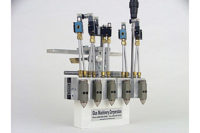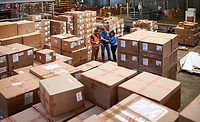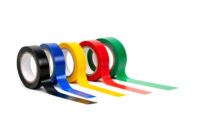Package and container sealing is a key component of today’s complex manufacturing processes. Manufacturers require a system that quickly delivers consistently applied adhesive while fitting into streamlined packaging lines. Many companies turn to hot-melt adhesive delivery systems for their packaging needs.
Traditional Systems
Traditional hot-melt systems that feature heated tanks often possess limitations that impact the efficiency and cost-effectiveness of packaging lines. These limitations include long start-up times, charring, contamination, plugging, time-consuming maintenance and danger to operators.
Long Start-Up Times
Heated tanks are slow to warm up; in fact, they can take more than 35 minutes to heat adhesive to a deliverable state. This means that the packaging facility spends more time waiting for the system to heat up and less time in operation.
Charring
Tank systems maintain large volumes of molten adhesive for hours or days. This long heat soak leads to glue charring. Charring also happens when the level of molten glue is allowed to vary widely. The glue on the side walls that is exposed to the atmosphere chars quickly. The charred material causes plugging in nozzles, leading to downtime on the packaging line. Excessive charring can also lead to premature failure of fluid seals in pumps and guns.
Contamination
Traditional tank systems do little to protect against contamination of hot-melt adhesives. Exposure to the environment, combined with the continual need for manual filling, allows dust, debris and materials from the facility to enter the tank. Foreign material contaminates the adhesive, thereby reducing its effectiveness and increasing the chance of nozzle plugging.
Plugging
Nozzle plugging represents one of the most problematic elements of traditional tank units. Plugs cause unplanned downtime and are costly. As a plugged nozzle is typically repaired when hot, it is a dangerous task.
Time-Consuming Maintenance
Heated tank systems require routine cleaning and maintenance to avoid adhesive char buildup. These cleanouts can be both labor intensive and time consuming, further impacting production line uptime. Large tank sizes result in a significant amount of wasted material whenever flushing is necessary.
Danger to Operators
Filling and cleaning traditional hot-melt tanks puts operators in close proximity to hot adhesive and hot system components.
Changing Technology
Recent advances in hot-melt equipment technology have dramatically improved upon the overall efficiency of traditional adhesive systems. The elimination of heated tanks, increased attention to material consumption statistics, and a focus on reliability has limited or removed many of the drawbacks of the previous generation of hot-melt adhesive dispensing systems.
One of the most apparent weaknesses of traditional hot-melt systems lies in the tanks themselves. These tanks take a lot of time to heat material, generate adhesive char and expose operators to hot adhesives. Now, tank-free systems use a vacuum feed to draw adhesive pellets into specially designed heating chambers. Pellets are melted on demand and dispensed quickly without overheating. The elimination of heated tanks improves hot-melt equipment performance dramatically. By reducing the amount of adhesive exposed to heat, the tank-free process allows for faster heating times.
The shortened exposure of the adhesive to heat also reduces the amount of char formation within the system. Quite simply, less time at temperature results in less adhesive char. With a minimal melted volume, hot adhesive is dispensed quickly and replenished with a fresh supply. The reduction of char leads to less material waste, fewer nozzle plugs, less overall system maintenance, longer fluid seal life and less production line downtime.
Finally, the use of a vacuum feed system keeps the ambient adhesive contained and closed from the outside environment, which reduces the chances of material contamination. Barring contaminants from the adhesive improves the dispensing process and helps ensure consistent adhesive application.
Intelligent Monitoring
Traditional hot-melt tank systems lack intelligence in terms of material usage monitoring. This information is vital to tracking expenses related to the packaging process. With material costs at the forefront of the manufacturing industry’s mind, monitoring solutions are becoming increasingly more important.
Emerging hot-melt technology offers the detailed material usage information many manufacturers desire. Intuitive user interfaces and USB downloadable operating data make it possible to track material usage clearly throughout a given period of time. This allows packaging managers to examine the amount of adhesive used over a single shift, a product run or another set amount of time. The increased tracking information leads to improved record keeping, better understanding of adhesive consumption and needs, and better control over costs in the packaging process.
In addition to material consumption, users now have the ability to track a number of other important factors, including fluctuations in material temperatures, system errors and key event history. This information is invaluable: running routine reports can pinpoint inconsistencies in the process, optimize the packaging line and identify cost-saving opportunities.
Increased Material Options
Some packaging companies find themselves transitioning to more expensive, temperature-stable adhesives in an attempt to negate some of the drawbacks of hot-melt tank equipment. While these adhesives have value to offer in their own right, adhesive choice should not be dictated by the capability of the processing equipment. New tank-free hot-melt systems have been designed around the broad spectrum of adhesives traditionally used in the market. All packaging-grade adhesives are available for use, including metallocene, EVA and others, expanding the options for packaging managers.
In addition, adhesive materials once viewed as incompatible with traditional heated tank systems due to their brief pot life stability or tendency to char have now become viable options for use with emerging tank-free systems. The viability—and often increased affordability—of these materials further expands the number of adhesive options accessible to the manufacturer.
Improving ROI
The advancements in hot-melt dispensing technology offer many potential benefits for manufacturers and packaging managers, including reduced downtime, lowered material costs, improved operator experience and improved information management.
Reduced Downtime
The elimination of lengthy heating times, combined with the reduction of charring and plugging, increases the uptime of production lines, thereby increasing the packaging line yield.
Lowered Material Costs
The expansion of viable adhesive options and more efficient adhesive use may lead to reduced material costs. By exploring additional material options, packaging managers may find savings in both the cost per pound of inventory ordered and the actual amount consumed per unit produced.
Improved Operator Experience
With a tank-free system, an operator no longer has to fill hot-melt pellets by hand, and the task of tank-scraping is eliminated. The elimination of the heated tank and reduced operator interaction with the system decreases the chance of burns and other injury. Reduced adhesive odor provides an overall better operator experience.
Improved Information Management
Information relating to material usage and line errors is important to tracking expenses, inefficiency and adhesive performance issues. This information is key to making adjustments to the system and maximizing the efficiency of the line. Monitoring each of these factors may dramatically improve your bottom line.
Improving Efficiency
Traditional hot-melt adhesive dispensing systems, while playing a large role in the packaging process, suffer from inefficiencies and weaknesses that can impact the effectiveness of the line. Emerging technologies eliminate many of the drawbacks of traditional heated tank systems and vastly improve the efficiency of the packaging process. These improvements generate an impressive ROI for tank-free hot-melt delivery systems.
For more information, contact the author at (330) 491-4476 or nlong@graco.com, or visit www.invisipac.com.






